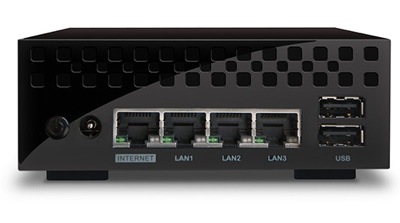LaCie (http://www.lacie.com) has introduced its first network-attached storage solution to feature Wi-Fi. Basically, it’s the company’s version of the Apple Time Capsule. It’s not quite as easy to set up as Apple’s product, but it’s still a serious competitor.
The LaCie Wireless Space can operate as a file or media server for multiple Mac and PC users, from anywhere in the home – making it the most compatible and multifunctional network hard drive on the market. The Wireless Space is bundled with LaCie Network Assistant, a application that provides device details for all LaCie network drives. Administration takes place in the Dashboard, a web-based administration tool that’s available on any system connected to the network or from a remote location.
On the back there are three Gigabit Ethernet ports that work as a switch and an upstream gigabit port. Also on the back are a pair of USB 2.0 ports for hooking up external drives or printers. Another USB 2.0 port is on the opposite edge, while inside there’s 2.4GHz single-band WiFi b/g/n and either a 1TB or 2TB hard-drive (I test drove the 1TB model).
Like Apple’s Time Capsule, the Wireless Space has one WAN port and only three LAN ports, as opposed to four ports as found in most other wireless routers. Unfortunately, unlike the Time Capsule, it doesn’t support dual-band, which the Time Capsule does.
That said, it is less expensive than Apple’s 1TB Time Capsule ($299) and 2TB Time Capsule ($499). The LaCie solutions, in the same configurations, are $229 and $349, respectively.
Unlike some network attached storage (NAS) devices, the LaCie Wireless Space can be integrated into a network in several ways. Foremost, it’s a network drive with a large capacity for data and media. But it’s also a router, a server, a Wi-Fi access point, and more.
The Wireless Space offers different configurations to work with most networks. No matter how it is used, the Wireless Space disk drive is always available to share files or backup on the network. You can choose the configuration of your choice, and opt to have the LaCie device:
° Creates its own network and connects directly to the existing wide area network (WAN) for access to the Internet.
° Join an existing wired network by connecting to the router, server or Internet provider;
° Join an existing wired network and having it manage its own Wi-Fi network;
° Join an existing wired network and having it manage its own wired network;
° Join an existing wired network and having it manage its own Wi-Fi network AND wired network;
° Join an existing Wi-Fi network.
In other words, leveraging Wi-Fi technology, the Wireless Space can connect to your existing Wi-Fi network, allowing you to access files wirelessly throughout the home, and can serve as a central storage solution for your back-ups. If you wish to increase your Wi-Fi performance, the Wireless Space can also act as a B/G/N access point, and even serve as a router.
Some of the configurations are no-brainers to set up. Others take a bit of work. I used the LaCie Wireless to creates its own network and connect directly to the existing wide area network (WAN) for access to the Internet. I actually to read the instruction manual to do this — and I urge you to, as well.
For users with a large media library, the Wireless Space can also act as a media server. It’s compatible with UPnP/DLNA and iTunes, and you can stream music, movies and photos from a central location and play them on any device.
You can use it as your network router. With static and dynamic port forwarding and PPo# connections, it performs even better than most cable routers, thanks to Wi-Fi n and Gigabit Ethernet performance. Additionally, the Wireless Space is Time Machine compatible.
Designed exclusively for LaCie, Neil Poulton’s black design is engineered for natural heat dissipation and near-silent operation. The LaCie Wireless Space is currently available in Europe in 1TB and 2TB capacities. Both models are available in the US through the LaCie Online Store, LaCie Corner, and LaCie Reseller+ starting at $229.99.
Macsimum rating: 8 out of 10
— Dennis Sellers

